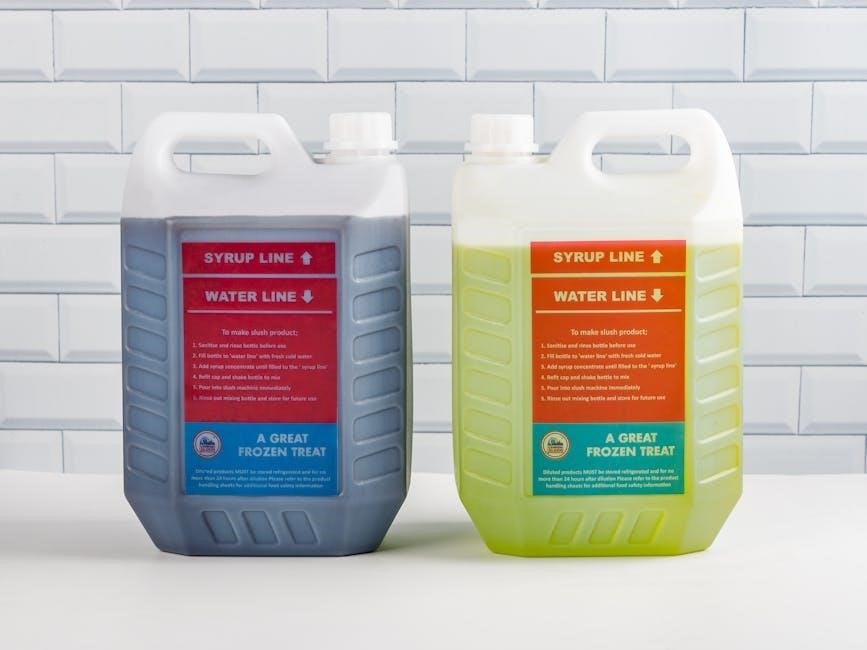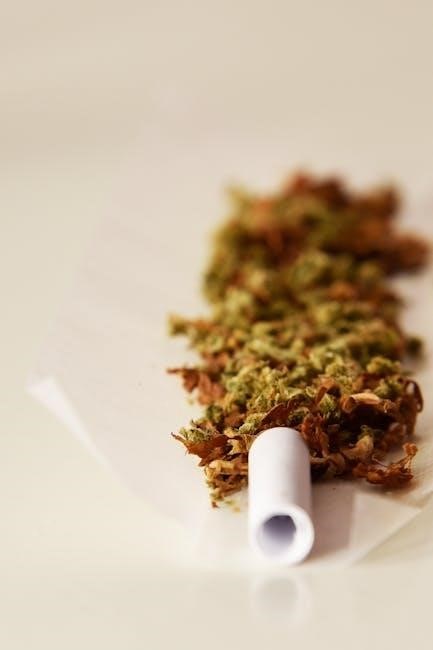Par 3 Weed Killer is a broad-spectrum herbicide designed for effective control of annual and perennial weeds in turf‚ lawns‚ and golf courses.
1.1 Overview of Par 3 Herbicide
Par 3 Weed Killer is a broad-spectrum herbicide formulated to control a wide range of annual and perennial weeds in turf‚ lawns‚ and golf courses. It is specifically designed to target hard-to-kill weeds‚ making it a trusted solution for professionals and homeowners alike. The herbicide works by thoroughly wetting foliage to ensure effective control. Its broad-spectrum activity ensures that it can manage various weed species‚ providing long-lasting results. Par 3 is widely recognized for its reliability in maintaining pristine turf conditions‚ particularly in golf course management. Proper mixing and application are essential to achieve optimal weed control while minimizing environmental impact. This herbicide is a key tool for maintaining healthy‚ weed-free landscapes in both residential and commercial settings.
1.2 Importance of Proper Mixing Instructions
Proper mixing of Par 3 Weed Killer is crucial for ensuring its effectiveness and safety. Incorrect mixing can lead to reduced herbicide performance‚ potential harm to desirable plants‚ or environmental contamination. Following the recommended water-to-herbicide ratio ensures the solution is applied at the correct concentration‚ maximizing weed control while minimizing risks. Proper mixing also prevents under-application‚ which may result in incomplete weed control‚ or over-application‚ which can damage turf or pose environmental hazards. Adhering to the instructions helps maintain the product’s efficacy and safety profile‚ ensuring it works as intended without unnecessary risks to people‚ pets‚ or the environment. Proper mixing is the foundation for successful weed management with Par 3 Weed Killer.

Safety Precautions Before Mixing
Wear PPE‚ including gloves and eyewear‚ to prevent skin and eye contact. Ensure proper ventilation and avoid inhaling fumes during the mixing process.
2.1 Personal Protective Equipment (PPE)
To ensure safe handling of Par 3 Weed Killer‚ wear long-sleeved shirts‚ pants‚ closed-toe shoes‚ and chemical-resistant gloves. Protective eyewear‚ such as goggles‚ is essential to prevent eye exposure. A face mask or respirator should be used to avoid inhaling vapors. Ensure all PPE meets the standards recommended by the product label or local regulations. Properly fitting and maintained equipment is crucial for effective protection. Always follow the manufacturer’s guidelines for PPE use during mixing and application.
2.2 Precautions to Avoid Exposure
To minimize exposure risks when handling Par 3 Weed Killer‚ avoid direct skin or eye contact. Wash hands thoroughly with soap and water after handling the product. If clothing becomes contaminated‚ remove and wash it separately before reuse. Avoid eating‚ drinking‚ or smoking while mixing or applying the herbicide. Ensure the area is well-ventilated to prevent inhaling vapors. Prevent accidental spray drift by maintaining a safe distance from desirable plants and water sources. Properly clean and rinse all equipment before and after use to avoid residual contamination. Always follow the product label’s safety guidelines to protect yourself and the environment.

Mixing Instructions for Par 3 Weed Killer
Always use the correct water-to-herbicide ratio and add surfactants for better coverage. Ensure proper sequencing when mixing with other chemicals for optimal effectiveness and safety.
3.1 Correct Water-to-Herbicide Ratio
The correct water-to-herbicide ratio is essential for effective weed control. Typically‚ mix 1 gallon of Par 3 Weed Killer with 100 gallons of water. This ensures consistent coverage and prevents under-application or over-application‚ which can reduce efficacy or harm plants. Always follow the product label for specific rates‚ as they may vary based on target weeds and growth stages. Proper mixing guarantees uniform distribution of the active ingredients‚ maximizing weed control while minimizing environmental impact. Double-check the ratio before application to avoid errors. Adjustments may be needed for different spray volumes or nozzle types‚ but the label-recommended ratio should remain the foundation for safe and effective use.
3.2 Adding Surfactants for Better Coverage
Surfactants are essential additives that enhance the effectiveness of Par 3 Weed Killer by improving spray coverage and herbicide absorption. These agents reduce the surface tension of water‚ allowing the herbicide to spread evenly across foliage‚ ensuring better penetration and adhesion. This results in more consistent weed control and reduces the likelihood of uneven application. Surfactants are particularly beneficial for hard-to-wet weeds or dense foliage‚ where coverage might otherwise be inadequate.
Typically‚ surfactants are added at a rate of 0.25% to 0.5% of the total spray volume. Always follow the product label for specific recommendations‚ as excessive surfactant can cause phytotoxicity. Nonionic surfactants are commonly used with Par 3 Weed Killer due to their compatibility with most herbicides. Ensure the surfactant is mixed thoroughly with the herbicide solution before application to maximize its effectiveness.

3.3 Sequencing with Other Chemicals
When using Par 3 Weed Killer in combination with other chemicals‚ proper sequencing is crucial to avoid incompatibility and ensure optimal performance. Mixing the herbicide with insecticides or fungicides requires careful planning to prevent adverse interactions. Always apply Par 3 Weed Killer separately from other chemicals unless specified on the product label or by a professional agronomist. If tank-mixing‚ add the herbicide last after all other products are well-dissolved to minimize potential conflicts. For sequential applications‚ allow at least 24 hours between treatments to prevent overstressing the turf. Avoid mixing with alkaline substances‚ as this can reduce herbicide efficacy. Always conduct a compatibility test with a small batch before full-scale application to ensure stability and effectiveness of the mixture.

Application Methods
Par 3 Weed Killer can be applied using small sprayers for targeted control or commercial sprayers for larger areas. Ensure thorough coverage for optimal results.
4.1 Best Practices for Spraying
For effective application‚ spray Par 3 Weed Killer evenly‚ ensuring thorough coverage of foliage. Use a sprayer with a fine nozzle to target weeds directly. Avoid spraying during strong winds or rain to prevent drift and runoff. Apply the herbicide in the early morning or late afternoon to minimize evaporation. Spray directly at the base of weeds for optimal absorption. Maintain a consistent walking pace to ensure uniform application. Avoid overlapping treated areas to prevent over-application. Clean equipment thoroughly before and after use to prevent contamination. Follow label instructions for tank mixing and nozzle selection. Always test a small area before full application to ensure compatibility with the target surface. Proper spraying techniques enhance efficacy and reduce environmental impact.
4.2 Recommended Sprayer Types
For optimal application of Par 3 Weed Killer‚ use a sprayer that ensures uniform coverage and precise control. A small handheld sprayer is ideal for spot treatments or small areas‚ while a commercial horticultural sprayer with a double trigger is recommended for larger lawns or turf. For extensive areas like golf courses or parks‚ a large commercial-grade sprayer with adjustable nozzles is most effective. Ensure the sprayer is calibrated correctly to deliver the recommended volume of herbicide per acre. Nozzle size and type should be selected based on the target area and weed density. Always clean the sprayer thoroughly before and after use to prevent contamination. Using the appropriate sprayer ensures efficient and effective application‚ minimizing waste and enhancing herbicide performance.

Timing of Application
Apply Par 3 Weed Killer during early morning or late afternoon for optimal absorption. Avoid spraying during strong winds or rain to ensure effective coverage and minimize drift.
5.1 Optimal Time for Weed Control
The optimal time for applying Par 3 Weed Killer is during the active growth phase of weeds‚ typically in early spring or late summer. For annual weeds‚ apply before they reach maturity to prevent seed production. Perennial weeds are best controlled when they are actively growing and before they produce flowers or seeds. Avoid application during extreme heat or drought‚ as this can reduce efficacy. Early morning or late afternoon applications are ideal to minimize evaporation and ensure better absorption by the foliage. Weather conditions‚ such as light rain or high humidity‚ can enhance herbicide effectiveness but avoid spraying if heavy rain is expected within 24 hours. Proper timing ensures maximum control and minimizes the need for repeat applications.
5.2 Weather Conditions for Effective Application
Weather conditions play a crucial role in the effectiveness of Par 3 Weed Killer. For optimal results‚ apply the herbicide when weather is calm‚ with no heavy rain or strong winds expected within 24 hours. Rainfall within this window can reduce efficacy by washing the herbicide off the foliage. Avoid spraying during high temperatures (above 90°F) or when humidity is extremely low‚ as this can lead to rapid evaporation and reduced absorption. Light rain or misty conditions can enhance herbicide performance by maintaining moisture on the leaves. Wind speeds should be below 10 mph to prevent drift and ensure accurate application. Ideal conditions are overcast skies or early morning/late afternoon when temperatures are moderate‚ promoting better absorption and minimizing environmental loss.

Environmental Considerations
Prevent runoff and drift to protect wildlife and water sources. Ensure proper application to avoid contamination of nearby ecosystems and water bodies.
6.1 Preventing Runoff and Drift
Preventing runoff and drift is crucial to minimize environmental impact. Apply Par 3 Weed Killer during calm weather to avoid spray drift. Avoid spraying when heavy rain is expected‚ as this can lead to runoff. Use low-pressure nozzles and maintain proper spray height to reduce drift. Ensure the herbicide is applied to dry foliage to enhance absorption and reduce runoff. Calibration of spray equipment is essential to avoid over-application. Always follow label instructions for the recommended rate to prevent excess herbicide from entering water sources or neighboring areas. Proper timing and adherence to environmental guidelines help safeguard wildlife and water bodies from contamination.
6.2 Protecting Wildlife and Water Sources
Protecting wildlife and water sources is essential when using Par 3 Weed Killer. Avoid spraying near ponds‚ lakes‚ or streams to prevent contamination. Use low-pressure nozzles to minimize drift and ensure the herbicide stays on target. Maintain a buffer zone around water bodies to reduce accidental exposure. Clean spray equipment thoroughly before and after use to avoid residual contamination. Keep pets and wildlife away from treated areas until the herbicide has dried completely. Properly dispose of unused herbicide and packaging according to local regulations to safeguard aquatic ecosystems. By following these guidelines‚ you can help protect the environment and ensure the safe use of Par 3 Weed Killer.

Effectiveness of Par 3 Weed Killer
Par 3 Weed Killer is a reliable‚ broad-spectrum herbicide effective against hard-to-kill weeds‚ making it a trusted choice for turf and golf course management.
7.1 Factors Affecting Herbicide Efficacy
The effectiveness of Par 3 Weed Killer depends on several factors‚ including proper mixing ratios‚ application timing‚ and environmental conditions. Weather plays a significant role‚ as rain or high humidity can reduce efficacy. The health and growth stage of target weeds also influence results‚ with younger weeds typically being more susceptible. Additionally‚ the presence of surfactants and compatibility with other chemicals can enhance or hinder performance. Proper calibration of spray equipment ensures uniform coverage‚ maximizing the herbicide’s impact. Adhering to the recommended application rates and avoiding drift onto non-target areas further optimize results. By carefully controlling these variables‚ users can achieve consistent and effective weed control with Par 3 Weed Killer.
7.2 Signs of Successful Application
Successful application of Par 3 Weed Killer is evident through visible signs of weed control. Within 7-14 days‚ treated weeds typically show wilting‚ yellowing‚ or browning of foliage‚ followed by complete death. For systemic herbicides like Par 3‚ the absence of regrowth indicates effective control. Optimal results occur when the herbicide is applied under ideal weather conditions and at the correct growth stage of the weeds. Proper mixing and application practices‚ as outlined in the instructions‚ ensure thorough coverage and penetration‚ leading to consistent and long-lasting weed suppression. Avoiding drift and ensuring the herbicide reaches the target weeds are critical for achieving desired outcomes. By following the guidelines‚ users can expect significant reduction in weed populations‚ promoting healthy turf and vegetation growth.

Troubleshooting Common Issues
Common issues with Par 3 Weed Killer include insufficient weed control‚ often due to incorrect mixing ratios or incomplete coverage. Proper recalibration of equipment and reapplication may resolve these problems effectively.
8.1 Insufficient Weed Control
Insufficient weed control with Par 3 Weed Killer can occur due to incorrect mixing ratios‚ improper application techniques‚ or reapplication intervals. Ensure the herbicide is mixed accurately according to the label instructions to maintain efficacy. If weeds persist‚ reapplication may be necessary‚ but avoid exceeding the recommended annual rate. Check equipment calibration to ensure uniform coverage‚ as uneven spraying can leave patches of untreated weeds. Weather conditions‚ such as rain shortly after application‚ may reduce effectiveness. Additionally‚ verify that the nozzle type and sprayer settings are appropriate for the target area. Always follow the manufacturer’s guidelines for optimal results and consider environmental factors that may impact herbicide performance.
8.2 Herbicide Incompatibility Issues
Herbicide incompatibility can occur when Par 3 Weed Killer is mixed with other chemicals‚ reducing its effectiveness or causing undesirable reactions. Always check the compatibility of Par 3 with other products before mixing. Some insecticides or fertilizers may react negatively‚ leading to reduced efficacy or equipment damage. Avoid mixing Par 3 with alkaline materials‚ as this can degrade the active ingredients. If unsure‚ perform a small-scale compatibility test by mixing a limited amount of Par 3 with the desired chemical in water. Observe for signs of precipitation‚ settling‚ or discoloration before applying on a larger scale. Follow the product label and consult the manufacturer if compatibility concerns arise.

Maintenance and Storage
Store Par 3 Weed Killer in a cool‚ dry place‚ away from direct sunlight and incompatible materials. Keep the container tightly sealed to prevent contamination.
9.1 Proper Storage of Par 3 Herbicide
Proper storage of Par 3 Herbicide is essential to maintain its effectiveness and safety. Store the product in a cool‚ dry‚ well-ventilated area away from direct sunlight and heat sources. Ensure the container is tightly sealed to prevent moisture and contamination. Keep the herbicide out of reach of children‚ pets‚ and unauthorized personnel. Avoid storing it near food‚ feed‚ or other agricultural products. Always follow the label instructions for specific storage requirements. Check the label for any temperature restrictions to ensure optimal conditions. Never store the herbicide in areas prone to flooding or leaks. Proper storage helps preserve the product’s integrity and prevents potential environmental hazards.
9.2 Disposal of Unused Herbicide
Disposal of unused Par 3 Herbicide must be handled responsibly to protect the environment and human health. Always follow local‚ state‚ and federal regulations regarding pesticide disposal. Do not pour unused herbicide down drains‚ sewers‚ or waterways‚ as this can lead to contamination. Check with your local waste management agency for designated hazardous waste collection facilities. Ensure the herbicide is in its original container with the label intact. If the container is empty‚ rinse it thoroughly and dispose of it according to local guidelines. Never reuse herbicide containers for other purposes. Proper disposal prevents environmental harm and ensures compliance with legal requirements. Always prioritize eco-friendly practices when handling agricultural chemicals.
